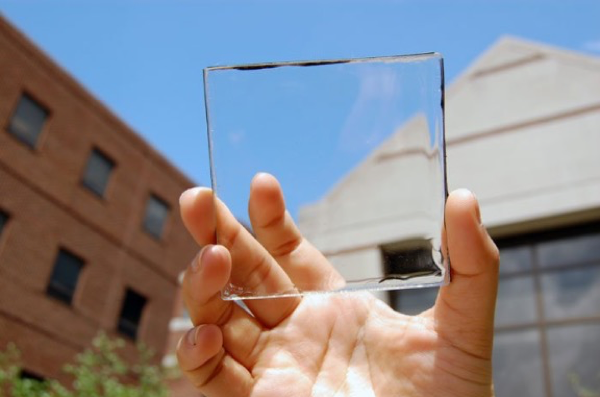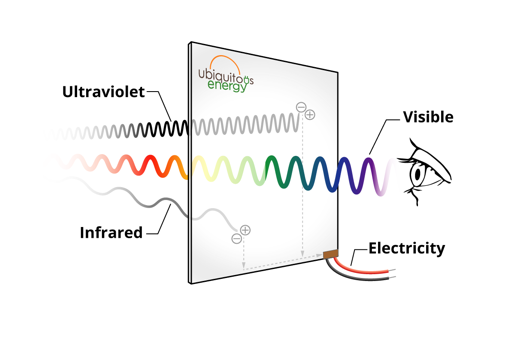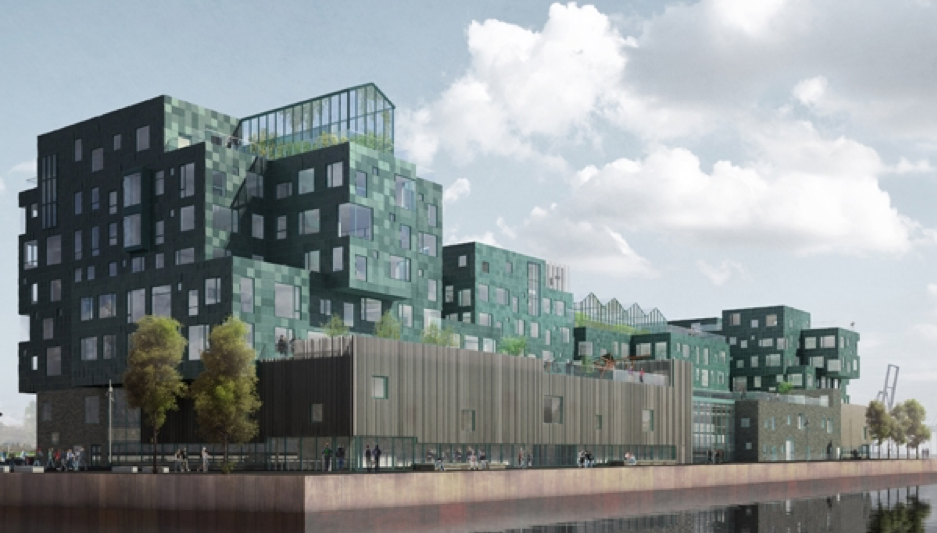
Buildings account for 40% of the global energy use. As a consequence, the mass realisation of net zero-energy buildings (NZEBs) is top priority for urban developers. therefore the integration of photovoltaics (BIPV) in the billions of windows is a top challenge that seems to be realized.
Promising steps
At first sight, harvesting energy from sunlight and maintaining full-transparency seem incompatible. Photovoltaics use ambient light at the same frequencies the human eye can see, and efforts to increase the efficiency of sun panels are at odds with maintaining transparency.
The past 10 years researchers at MIT, UCLA, Michigan State University and several other institutions – Delft Technical University among them – have made progress in bridging both objectives[1].
Until to date Luminescent Solar Concentratorsare the most promising technology to combine harvesting electricity and transparency[2].

Luminescent solar concentrators catch both diffused and direct solar radiation. The light penetrates a so-called waveguide, a polymeric or glassy optical plate or thin film coated with luminescent materials. Within the waveguide the light is moving sideways. It is absorbed and turned into electricity by narrow strips of photovoltaic cells, which are either sporadically embedded in the plate or placed at the plate’s ends.

The efficiency of the process depends largely from the chromophores, the particles in the luminescent coating that have to catch as much light as possible. At the same time, these particles need to change the wavelength of the light in order to prevent other particles absorbing the light again on its way to the photovoltaic cells in the periphery of the window. For the time being, the effectiveness of this process is at the expense of the transparency of the window. With other words, the more electricity is harvested, the less transparent the window is. Nevertheless, the results so far already are commercialized successfully[3]. A few examples:

Onyx Solar
Onyx solar is a global company (Spanish by origin) that is developing and producing energy harvesting glass panes for construction and retrofitting purposes[4]. Onyx Solar offers fully glass panels in stunning designs and in in specific colors, shapes and transparency (title picture). The company is able to trade off different degrees of transparency and color with different degrees of harvesting electricity. For instance, its most transparent panels (XL Vision) combine a transparency of 30% with a peak power of 28 watt (m2)[5]. This is about 25% of the output of ‘regular’ thin film solar panels[6].

Physee
Physee is a startup from Delft Technical University in the Netherlands[7]. During the 2017 World Economic Forum, the company was called ‘technology pioneer’. Its flagship product is the Power Window, which surpasses the transparency of Onyx’s windows, but – not by surprise – has a lower electricity generating capacity: 8 – 10 watt (m2)[8]. The company deploys thulium, a rare earth metal on the waveguide, together with a CIGS PV-cell strip attached to one glass-edge[9]. Currently, a few companies are deploying Power Windowsto support the development of this ambitious B-company.

Is a break-through underway?
A couple of years ago, a team directed by Richard Lunt of Michigan State University, took a different approach[10]. The principle behind it resembles that of the LSC discussed above. The concentrator also is a thin layer of material that can be placed on windows, phone screens or any flat, clear surface. Its thickness is less than 1/1,000th of a millimeter, and it is virtually indistinguishable from glass. This layer captures the photons of ultraviolet and infrared light while allowing the photons of visible light to pass through. For this reason, the result is exceptionally transparent to the human eye.

This technology is called ClearView power. The short video below is disclosing some technical details of this technology.
Ubiquitous Energy
In an effort to commercialize transparent solar technology Lunt founded the company Ubiquitous Energy[11], which is currently in the rolling out its first windows/panels for commercial use. I couldn’t find information about the window’s electricity generating power at this time, except that the company announced that 50 watt (m2) is feasible.
Meanwhile…..
architects and urbanists might follow the example of theInternational School in Copenhagen[12]that covered 6000 m2 of its walls with green solar panels to produce more then 50% of its electricity and also to contribute significantly to the building’s aesthetic.

[1]http://www.glasstopower.com/g2p/wp-content/uploads/2017/12/Luminescent_solar_concentrators_Brovelli.pdf
[2]J.W.E. Wiegman, E. van der Kolk, Building integrated thin film luminescent solar concentrators: detailed efficiency characterization and light transport modelling, Solar Energy Materials & Solar Cells 103 (2012) 41-47.
[3]https://www.business.com/articles/transparent-solar-windows-construction/
[4]https://www.onyxsolar.com/projects
[5]https://www.onyxsolar.com/product-services/technical-specifications
[6]The bottom of this sector of the Onyx Solar website compares in a visual way the levels of transparancy: https://www.onyxsolar.com/product-services/amorphous-pv-glass
[7]http://www.physee.eu/products#powerwindow
[8]http://www.wattisduurzaam.nl/5871/energie-opwekken/zonne-energie/30-vierkante-meter-delftse-zonneramen-rabobank-eindhoven/
[9]The applicability of thulium has been studied by Lisset Manzano Chávez, in her master theses Optimization of a Luminescent Solar Concentrator: Simulation and application in PowerWindow designat the Delft University of Technology.
[10]The principles behind this process are disclosed in a paper titled ‘Emergence of highly transparent photovoltaics for distributed applications’, published in Nature Research (2017)
[12]https://inhabitat.com/this-danish-school-is-completely-covered-with-over-12000-sea-green-solar-panels/

